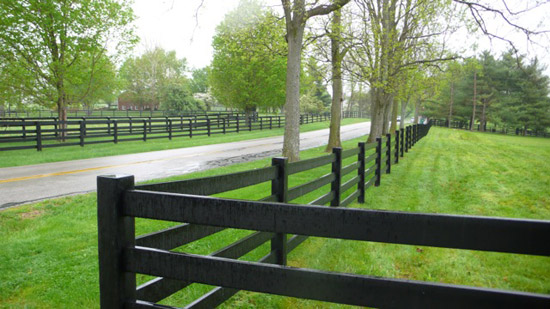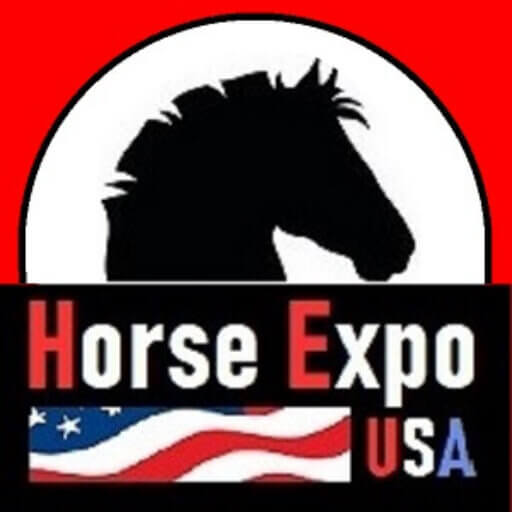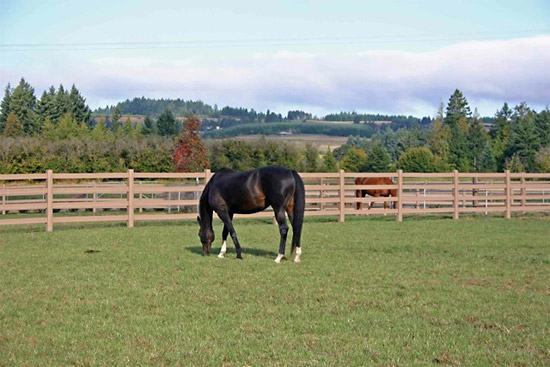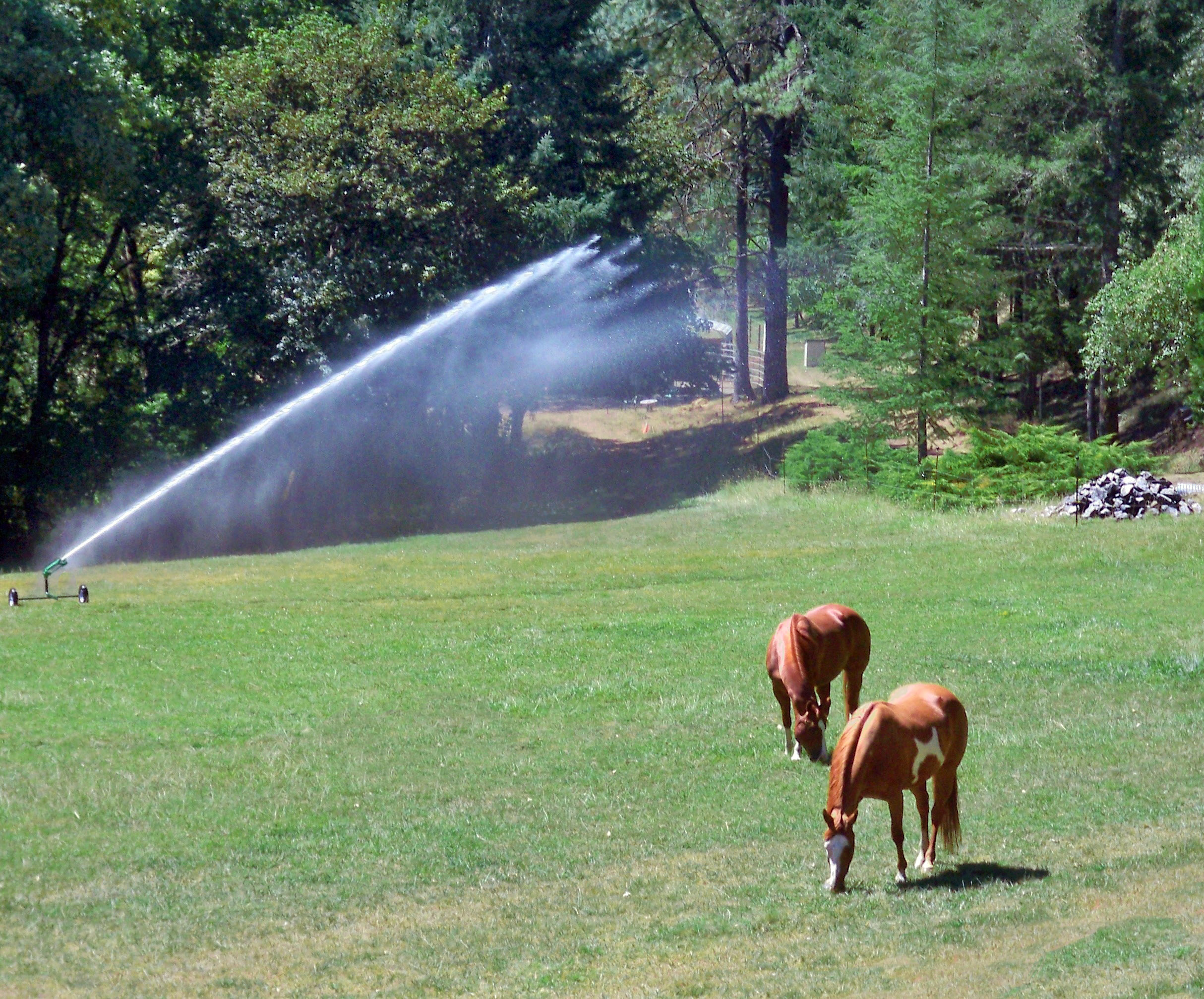Article by WindRiver Fence
WindRiverFence.com
It is my intention in this brief article to touch on a few of the more popular types of horse fencing and offer the pros and cons of each type.
One could probably teach or take a semester long course on fencing. There are nearly as many types and brands of fences as there are breeds of horses.
First and foremost livestock fences are meant to contain the movement of the livestock. We all know that critters both equine and bovine have a way of thwarting these efforts. How many of us have received a call or a knock on the door reporting the misadventures of one of our animals who miraculously seemed to “dissapperate” from one side of our perfectly good fence to the other. These innocent forays set off a miserable chain of events including the retrieval and re-incarceration of our traveling friends and then the tedious business of figuring our how and where he or she managed to breach the fence. Temporary repairs must be effected followed by a more permanent solution.
Two other more serious conditions may occur when horses (in particular) breach a fence. That is they may become injured. I spoke with a woman at a horse-show recently who said she nearly lost her Arabian mare when it broke through a PVC fence-post and cut an artery because the PVC shattered. This can happen with many types of fence. Wire, wood, metal and especially PVC can actually harm the very animals intended to be kept from harm. The only material that comes close to truly safe containment is high density polyethylene (HDPE) ranch-rail (or farm-plank) which is both strong and extremely resilient in all weather conditions. In fact, it remains pliable to negative 100 degrees F. Almost every other material retains a mechanism of injury for instances when 1,000 plus pounds of ornery horse meets fence. So, when your horse breaches your fence, it can be hurt in the process and as a result by running into a road and being struck by a car or truck.
So, lets talk about some of the types of fence available.
Wooden fences are probably the oldest form of fence in the world. In the ancient world fences were used more to keep livestock out than in protecting gardens and common domestic living areas. Wood was used because it was an abundant material and it could easily be replaced when necessary. Today, wood remains one of the most common materials for fencing and includes post and rail of the natural variety with a minimum of milling to standard milled plank and post. While one of the most visually pleasing fences when installed, it can deteriorate and requires replacement at least every 10 years or so because the posts rot at or just below ground level. In addition, coatings such as paint, whitewash or formerly creosote (now outlawed) was necessary to keep wooden fences from rapid deterioration. While wood is relatively inexpensive going in, it is one of the most expensive materials to maintain.
Metal fences come in a wide variety of shapes sizes and type of materials used. From basic pipe fence to various types of wire, stranded, meshed, electrified and barbed. While many of these seem like a reasonably priced solution going in, the long term cost may be more than the land owner bargained for. I now live in Arizona where rusty metal pipe is king. While this can be a bit costly going in, it is relatively maintenance free. The only downside of this material is that in anywhere other than the rugged desert landscapes of the Southwest, it looks like a junk-yard dog ought to be prowling the interior spaces looking for nare-do-well bargain hunters. Pipe can be painted and some premium pipe brands even come powder or plastic coated. (These brands are probably the most expensive of all fences on the market and unfortunately still tend to rust at the connections requiring constant upkeep.) The other potential disadvantage of pipe fence is its lack of “give”. If a horse hit’s it hard, the pipe will usually win. Horses have been known to suffer broken legs from a feisty encounter with a pipe fence.
Wire fences too are plentiful and relatively inexpensive (at installation). Again the true cost (over time) of wire fence comes in the form of maintenance and possible injury. Horses have a difficult time seeing single or horizontal strand fencing. It tends to blend into the background and the horizontal features camouflage themselves because all animals are used to seeing the horizon and tend not to see long linear runs of wire. (What we and horse do see are the vertical posts that delineate the perimeter.) When a horse comes into inadvertent contact with a single or multiple strands of wire it can be harmful. Mesh or no-climb fence can take care of this factor somewhat, but it too has its issues. First, it is difficult for humans to transit no-climb fences, so a number of gate may be required in order to access your animals in the field.
Plastic fences have become popular in the last twenty five years. There are two types of plastic fence but most people know about only one of these. Unfortunately, those horse owner who do know about polyvinyl chloride (PVC) fences don’t care much for it and with good reason. PVC is primarily used for vinyl siding and this is a huge industry. The manufacturing process of siding and post and rail production are very similar and so a new product line was started by the vinyl siding manufacturers to sell more product. Unfortunately, vinyl is a less than ideal product for livestock. In fact, the fine print of many PVC brands caution against using it for livestock. PVC can cause severe injury to horses because it shatters in cold weather or even warm given enough impact. (Say a 1,200 pound horse determining that the grass is greener over yonder!) We have spoken with many a former PVC fence owner who would never, ever entertain the idea of using this for their horses again.

Learn More Here
The best product on the market today for horses is high density polyethylene or HDPE. HDPE fence was first invented and manufactured by WindRiver Fence in 1991 and was created specifically for the equine market. WindRiver HDPE fence remains resilient from 150 degrees F to minus 106 degrees F. WindRiver Fence is available in six standard colors including black, white, gray, weathered wood, redwood, and green. It is not only maintenance free, but remains durable for well past its twenty-year warranty life. WindRiver Fence is beautiful going in and remains so, year after maintenance free year. With hundreds of miles of product in the field, WindRiver Fence is the best choice for you, your horses and your property. For more information, please call 800-269-4672 or by email, sales@aeo1.com, and visit our webstie:WindRiverFence.com. Please mention code IH99 for an instant 2% discount.
Contact: Our Friendly Staff
P.O. Box 888
Latrobe, Pennsylvania 15650
Phone: 800-269-4672
Email: sales@aeo1.com
Website: WindRiverFence.com





